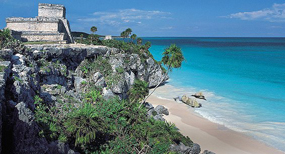 As the weather cools down over much of the United States, southern destinations take on a lot of appeal for pilots. AOPA receives numerous calls this time of year about flying to Mexico. Many pilots are confused about the complexities of border-crossing procedures—and questions about eAPIS continue. Nevertheless, if the beaches of the beautiful Mexican resorts or some of the other Mexican attractions call you south, go ahead and give in to your dreams—just be sure to do a thorough trip preparation first. Here is a summary of what you need to know.
As the weather cools down over much of the United States, southern destinations take on a lot of appeal for pilots. AOPA receives numerous calls this time of year about flying to Mexico. Many pilots are confused about the complexities of border-crossing procedures—and questions about eAPIS continue. Nevertheless, if the beaches of the beautiful Mexican resorts or some of the other Mexican attractions call you south, go ahead and give in to your dreams—just be sure to do a thorough trip preparation first. Here is a summary of what you need to know.
- For all travel to any foreign country, including Mexico, Canada, and the Bahamas, current passports are required for all and the PIC must also have a pilot certificate with an English proficient endorsement, a current medical certificate, and a restricted radiotelephone operator’s permit.
- Children traveling with only one parent must have a notarized statement of approval from the absent parent stating the dates of the trip.
- Regarding 406 ELTs—The Mexican equivalent of the FAA, Direccion General De Aeronautica Civil (DGAC) has extended the compliance date for 406 MHz ELT equippage in order to fly in Mexican airspace. Pilots now have until April 2, 2010 to comply, with a few exceptions. Pilots who install a new ELT between now and April 2, must install a 406 MHz ELT in order to fly in Mexico. In addition, if the batteries on a 121.5 MHz ELT expire or need to be replaced before April 2, Mexico requires that the unit be upgraded to a 406 MHz ELT. Read more.
- Tourist cards (immigration forms) are required for all visitors and you will be asked to fill them out at your first airport of entry in Mexico.
- Other required certificates, licenses, paperwork, and equipment are listed online.
- Twelve-inch registration marks are required for crossing the ADIZ into Mexico.
- Do verify that you have insurance coverage for flight into Mexico and that the policy specifically states that liability insurance in Mexico is provided. AOPA’s Web site provides a list of insurance companies that do provide coverage should you need to add it. Bring the original policy along with two additional photocopies.
- U.S. Customs and Border Protection (CBP) requires an annual user fee decal ($27.50). Allow a few weeks for delivery. 2010 decal renewals are available now and CPB encourages all applicants to use the online renewal process. Pre-printed paper applications will be mailed only by request—not automatically sent as in previous years. To request a pre-printed paper renewal application, call the User Fee Help Desk at 317/298-1245, option 3; or email [email protected].
- All pilots flying from the U.S. to Mexico (or to any other country) are required to use eAPIS—CBP’s Electronic Advance Passenger Information System. If you want the whole story on using eAPIS, take AOPA Air Safety Foundation’s free online tutorial: “Understanding eAPIS - A Pilot’s Guide to Online Customs Reporting.”
Caribbean Sky Tours, which is headquartered in Cancun, Mexico, offers personalized service to pilots wishing to fly to Mexico, Bahamas, and Central America, publishes a Pilot’s Guide to Mexico, and offers a robust Web site with helpful information, as well as a variety of VFR and IFR charts for Mexico. Links to other Caribbean travel resources, including Caribbean Flying Adventures and Baja Bush Pilots, can be found online.
And, of course, call AOPA’s Pilot Information Center with questions Monday through Friday, 8:30 a.m. to 6 p.m. Eastern Time, 1-800-USA-AOPA (872-2672). We’ll be glad to help in any way we can. Feliz vuelo en México! (Happy flying in Mexico!)



